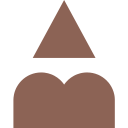The SIAD Saint-Jean is the Home Nursing Service of the Saint-Jeannaise region (Isère). The association provides hygiene, nursing, and comfort care, as well as moral and psychological support at the homes of elderly people over sixty years old who have lost autonomy, and people with disabilities, in order to ensure their continued residence at home.
The SIAD logo features a bird from the large family of passerines, with the house sparrow as the most well-known representative.
Associated with the goddess of love Aphrodite, the sparrow is synonymous with joy and vitality.
In the Middle Ages, it symbolized the countryside and peasants, as well as friendship and hospitality (it is actually called the house sparrow in English).
It is the most familiar of wild animals (the closest to humans), but also the most social and cheerful. The sparrow is a lively animal, full of energy, hardworking, cooperative, and devoted.
In the Middle Ages, it symbolized the countryside and peasants, as well as friendship and hospitality (it is actually called the house sparrow in English).
It is the most familiar of wild animals (the closest to humans), but also the most social and cheerful. The sparrow is a lively animal, full of energy, hardworking, cooperative, and devoted.
It is found in gardens worldwide and lives in harmony with humans and nature. Familiarity, solidarity, availability (mobility), and thoughtfulness are also the values of SIAD members who, like sparrows, are welcomed into the homes of the canton.
In addition to a house sparrow, the logo may also evoke a gray wagtail (which some associate with the Caladrius due to the skull-like pattern on its head that is subtly reflected in the logo); or even the little, lively wren with its raised tail.
In addition to a house sparrow, the logo may also evoke a gray wagtail (which some associate with the Caladrius due to the skull-like pattern on its head that is subtly reflected in the logo); or even the little, lively wren with its raised tail.
Photo credit: Artem Makarov
The SIAD logo also evokes a legendary bird: the Caladrius.
Also called Caladre or Charadrius, the Caladrius is a fabulous bird from the Middle Ages. The many bestiaries that mention it do not all describe it the same way, allowing for its varied representation.
Sometimes resembling a heron, as large as a crow, the Caladrius had white plumage and the tail of a serpent. Capable of healing the sick with a simple look, the Caladrius seems to have indeed existed, and its power—real and documented—could be compared to the placebo effect.
Sometimes resembling a heron, as large as a crow, the Caladrius had white plumage and the tail of a serpent. Capable of healing the sick with a simple look, the Caladrius seems to have indeed existed, and its power—real and documented—could be compared to the placebo effect.
The Legend of Caladrius
If a man is stricken with an illness, one can know through the Caladrius whether he will live or die. If the man's illness is fatal, as soon as the Caladrius sees him, it turns its eyes away from the sick man, and from then on, it is known that he will die. And if the illness is not among the fatal ones, the Caladrius looks at the sick man and gathers within itself all of the man's infirmities, then it flies into the air towards the sun, and there it burns all the infirmities of the sick man and disperses them, and thus the sick man is healed.
Pierre de Beauvais, Bestiary







(Left) Inspired by the French typeface Peignot in an engraved version, this custom typography aligns with the pictogram in their respective play of filled and empty spaces.
(Right) This alternative and more open version is both more faithful to the spirit of the pictogram (with its open lines) and the typography of the previous logo.
(Right) This alternative and more open version is both more faithful to the spirit of the pictogram (with its open lines) and the typography of the previous logo.
Pine Green represents the green of the natural spaces of the Saint-Jeannais region.
It symbolizes both the Bonnevaux forest and its four firs, as well as the Montjoux pond, its colors, vitality, and ecological richness. It is also a reference to the green paint of the windows of the Jules Verne school (association site).
It symbolizes both the Bonnevaux forest and its four firs, as well as the Montjoux pond, its colors, vitality, and ecological richness. It is also a reference to the green paint of the windows of the Jules Verne school (association site).
Garden Green evokes the freshness and vitality of the gardens of the former canton of Saint-Jean-de-Bournay; but also the Jardin de Ville in the heart of the town, and the serenity of the Dauphiné hills.
Canvas White refers to the historical activity of hemp canvas production for the Navy, and the revolutionary name of Saint-Jean-de-Bournay during the Revolution: Toile-à-Voile.
It is also the color of the walls of the Jules Verne school and that of the Town Hall.
It is also the color of the walls of the Jules Verne school and that of the Town Hall.











